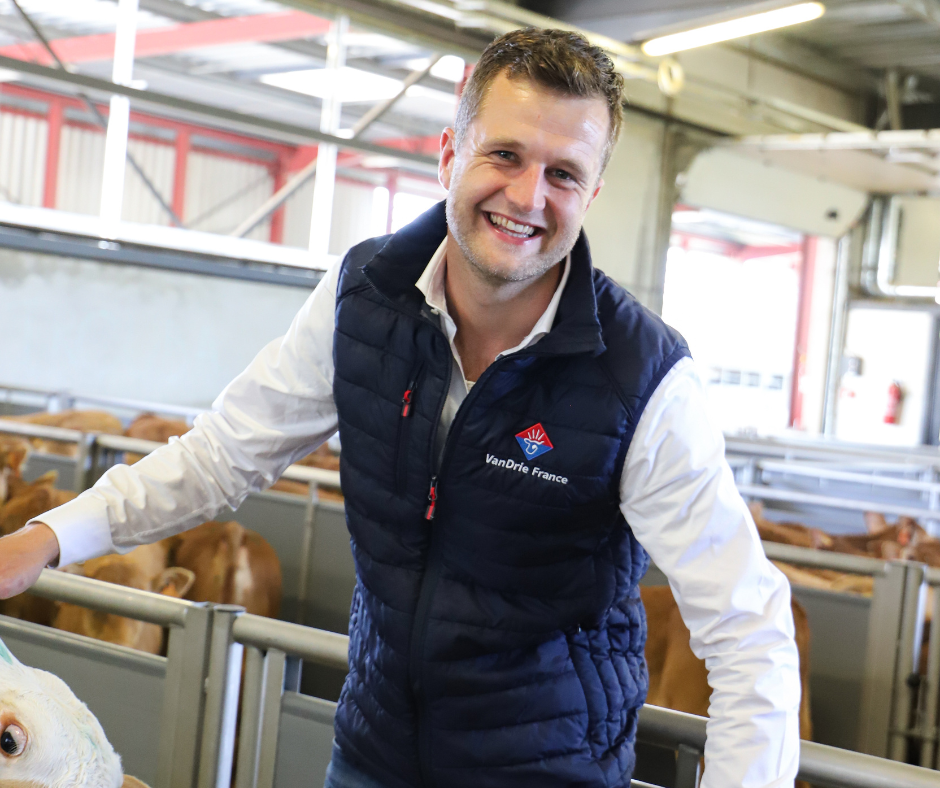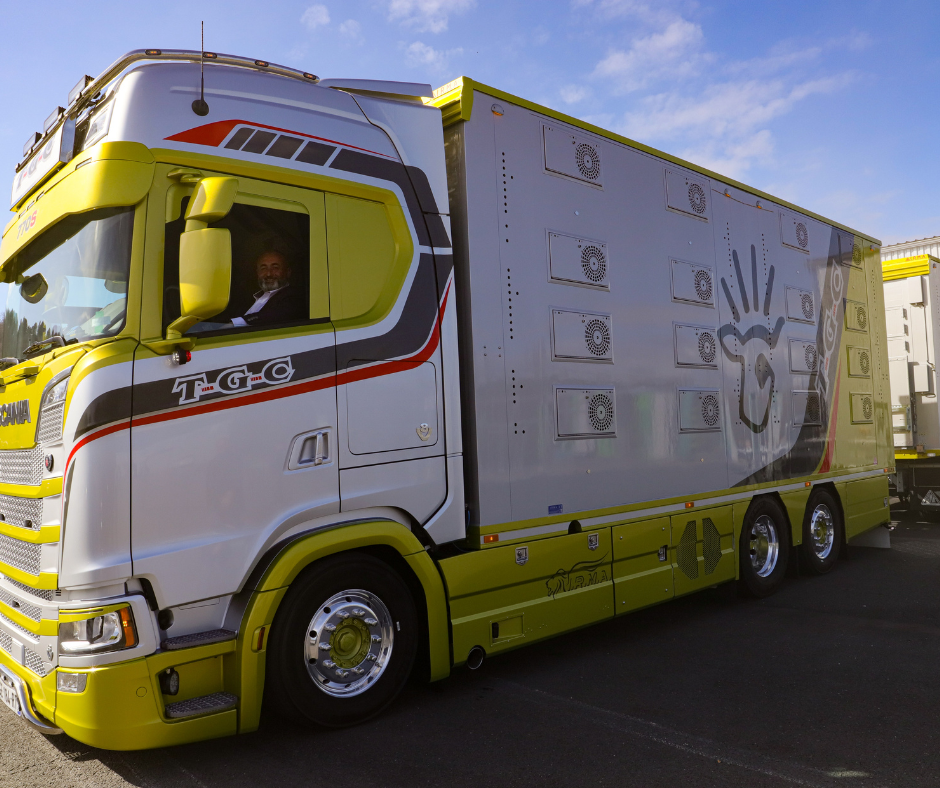In conversation with… Gerjan van Drie

In 1994, the VanDrie Group took its first major step on the French market with the takeover of French integrated veal producer Sobeval. Now, 25 years later, following the addition of the young animal feed producer Schils, the veal producer Tendriade and strong organic growth to 150,000 places for calves, the company has managed to secure an enviable position in the French market. The French market differs in fundamental ways from that in the Netherlands. Not only is the French consumer traditionally a veal eater, but the agricultural sector in France is also relatively smaller in scale and the supplying veal farmers have organised their operations in a different way. With the experience and knowledge from the Netherlands, the VanDrie Group is investing in sustainable integration in France. Gerjan van Drie, one of the grandsons of the founder of the VanDrie Group and co-representative of the third generation of the family business, has been responsible for the husbandry of Van Drie France since 2018. He talks about this market and his objectives there.
What are the most important characteristics of the French market for the VanDrie Group?
‘That is already evident with the consumer straight away. French people spend a lot more time and money on their food than Dutch people. If I go the market here at the weekend, I see a clear difference between how the French people walk around the market and how a Dutch consumer does that. More value is attached to origin and quality in France. Traditionally, the Frenchman is a veal eater and many French consumers have a preference for a specific breed, such as Limousin. That experience doesn’t exist with the Dutch consumer.
In addition, France is the largest country in Europe after Russia and Ukraine, and that requires an organisation set up for that. The 500 veal farmers who are under contract with us are supplied from four collection centres that are well distributed across the country. About 5,000 calves from dairy farms come together at those collection centres every week, and we subsequently transport them to the veal farms in the most efficient way possible. This concerns a broad range of breeds and species in different weight categories. That has been the case traditionally and is typical of the French market. We therefore select them carefully. So, one stall is intended for black and white Holstein calves and the other stall for a mixture of French cross of meat breeds. In this way, you try to get the best possible result from a technical and economic perspective with the most uniform possible herd.

Which opportunities are there for husbandry?
‘French calf husbandry is a shrinking market, and the current generation of veal farmers is growing older relatively speaking. Nevertheless, we added 50,000 places for calves in the period from 2016 to 2021 by actively focusing on attracting, supporting and guiding new veal farmers.
In the Netherlands, a new veal farmer usually has a calf shed built himself/herself and subsequently opts for an integration to collaborate with. In France, young, starting entrepreneurs can turn to the VanDrie Group for the choice of calf shed. They can choose between two calf shed concepts, which have already been tried and tested for about eight years. We offer the veal farmer a contract and work according to agreements, as a result of which the calf shed can be written off in 15 years. The banks know our company, the contract, our types of calf sheds and if the potential new veal farmer has a good profile, the banks will provide the necessary financing. In addition, we guide the veal farmers intensively.
Our team of about 35 field staff members know the two calf shed concepts well and can therefore provide optimal support to veal farmers. Because the basis is the same at all companies, they now dream about milk preparation and ventilation protocols. This contributes towards constant improvement of the results.’
What are your important sustainability themes in France?
‘The most important theme in France is animal welfare, followed by environment, surroundings and food safety. With our experience, we can really make a difference in France as the VanDrie Group. Our staff receive training in proper treatment of animals, of course, and our collection centres are regularly audited for compliance with all legislation and regulations.
We have a team of technical people who provide guidance at the calf sheds and fulfil a key role with regard to animal welfare. They are aware of the importance and constantly given further training.
The two calf shed concepts are continually evaluated and adjusted. In 2021, we launched a premium concept. As a result of this, the cows in the shed, which have been built since January last year, are always on rubber grilles, softer floors. That is a major investment. We also ensure there is sufficient natural light in the shed. Though no relevant standard exists for this in French calf husbandry, our own concepts dictate that the window area must equal at least five percent of the shed’s surface area. We are therefore above the national standard of three percent that applies to other animals in intensive livestock farming. At the same time, that is a focus point for existing sheds: how can we transform them sustainably without it becoming unaffordable? We are continuously in dialogue with our veal farmers about that.
I am endeavouring to bring the best ideas from the Netherlands and to make them fit and practicable in France too. For example, we follow the Dutch objectives with regard to antibiotics. France does not yet have any statutory objectives that need to be achieved. As Van Drie France, we only use antibiotics curatively and if strictly necessary. We register the use of antibiotics for each farm and each calf. As a Dutch company, we are trying to be in the vanguard in France and to organise our affairs properly. As a company, you have to lead the way there and also be insistent sometimes. That doesn’t always happen automatically.’
How is the cooperation with your veal farmers arranged?
‘Our 500 veal farmers have joined forces as a trade union of VanDrie veal farmers in France. That is a typically French solution and strengthens mutual contact. Each region in France has its own representative and I meet with them three times a year. There is also a sector meeting in each region annually, where I present the results, new developments and objectives, including the performance on the basis of our quality system. Those meetings are instructive and constructive. We discuss what they expect from us and vice versa. And, of course, I also attend the annual general members’ meeting organised by the union.’
‘The most important theme in France is animal welfare. With our experience, we can really make a difference in France as the VanDrie Group.
Gerjan van Drie
How you handle the feed composition and supply?
‘The calf milk and the roughage are made by the VanDrie Group itself. The other raw materials, especially corn, are blended locally per region. That work is carried out by companies with which we have worked together well for many years. We have been purchasing our straw from our own straw factory since 2017. As a result of this, we are able to guarantee the availability and quality.
Traditionally, the veal farms in France are usually mixed farms. Smaller farms with 100 or 200 calves. They mainly receive their feed as bagged goods, but we are trying to switch all of the larger companies to bulk. That is a transformation. The number of smaller farms is shrinking and they are being replaced by larger operations with an average of about 400 calves. We support the veal farmers that decide to do this by paying for the required animal feed silos.
You are also working on animal-friendly transport, aren’t you?
‘Yes, we have been working in France with the transport company Gargaud for many years and by working together with them, we came up with the idea to purchase a climate-controlled, closed truck for the transport of primarily young calves. Gargaud purchased that vehicle and we pay them a rate per calf for that. That is something new in France and is comparable to the vehicles that the VanDrie Group uses in the Netherlands. You sometimes have considerable transport distances in France and it is also often warmer. We want to set a new standard with these trucks.

I had an instruction book, which was recently developed by the VanDrie Group in the Netherlands, about animal-friendly loading, unloading and transporting translated into French. We use that now in our French organisation and with our French veal farmers. This is one of the examples how our Dutch and French organisations are strengthening each other. Conversely, if something is developed in France, this is also made available to our branches in the Netherlands.
It is genuinely important for our company to continue becoming more sustainable and continue cooperating with veal farmers. That way, you can deliver optimal performance.’